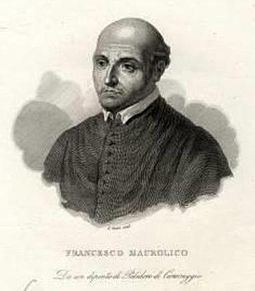Name Francesco Maurolico Role Mathematician | ||
 | ||
Francesco Maurolico, a Renaissance interpreter of Euclid, Veronica Gavagna, Università di Firenze
Francesco Maurolico (Greek: Φραγκίσκος Μαυρόλυκος, Frangiskos Mavrolikos; Latin: Franciscus Maurolycus; Francisci Maurolyci; Italian: Francesco Maurolico; 16 September 1494 - 21/22 July 1575) was a mathematician and astronomer from Sicily. Born to a Greek family and immersed in the study of classical Greek texts, throughout his lifetime he made contributions to the fields of geometry, optics, conics, mechanics, music, and astronomy. He edited the works of classical authors including Archimedes, Apollonius, Autolycus, Theodosius and Serenus. He also composed his own unique treatises on mathematics and mathematical science.
Contents
- Francesco Maurolico a Renaissance interpreter of Euclid Veronica Gavagna Universit di Firenze
- 1 2 3 Infinity Proof by Mathematical Induction
- Life
- Accomplishments
- Works
- Death and legacy
- References
1, 2, 3 ... Infinity. Proof by Mathematical Induction
Life
Born in Messina of a family of Greek descent who originated in Constantinople, they settled in this Sicilian city after the Fall of Constantinople (1453). Recent studies seem indeed to indicate that the family settled in Messina at the end of 15th century. Maurolico received a solid education. His father, Antonio, had been a physician and studied under the famous Hellenic scholar Constantine Lascaris and later became Master of the Messina mint. The Maurolico family had a villa outside the city.
In 1521, Maurolico took holy orders. In 1550, he entered the Benedictine Order and became a monk at the monastery of Santa Maria del Parto à Castelbuono. Two years later, he was consecrated as abbot at the Cattedrale San Nicolò di Messina.
Accomplishments
Like his father, Maurolico also became head of the Messina mint and for a time was in charge of maintaining the fortifications of the city on behalf of Charles V, Holy Roman Emperor. Maurolico tutored the two sons of Charles' viceroy in Sicily, Juan de Vega, and had the patronage of many rich and powerful men. He also corresponded with scholars such as Clavius and Federico Commandino. Between 1548 and 1550, Maurolico stayed at the castle of Pollina in Sicily as a guest of the marquis Giovanni II Ventimiglia, and utilized the castle tower in order to carry out astronomical observations.
Maurolico's astronomical observations include a sighting of the supernova that appeared in Cassiopeia in 1572. Tycho Brahe published details of his observations in 1574; the supernova is now known as Tycho's Supernova.
In 1569, he was appointed professor at the University of Messina.
Works
Death and legacy
He died at Messina.
The lunar crater Maurolycus is named after him.
There is a school in Messina with his name.
In 2009 the Italian Ministry of Cultural Heritage has ordained the establishment of the Edizione nazionale dell'opera matematica di Francesco Maurolico (National Edition of Maurolico's mathematical oeuvre).
